

25 Best Education Sites & Apps For 2020. It's the time of year again for my favorite annual sites and apps.
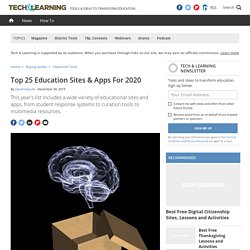
This year's list includes a wide variety of educational tools, from student response systems to curation tools to multimedia resources. Many are new and some are free. As always, tools listed in previous end-of-year posts are not eligible for this year's list. Wakelet - Wakelet lets educators bookmark any item on the web (i.e. article, blog, tweet, etc.), curate them in stunning visual ways, and invite others to collaborate. Wakelet is great for digital storytelling, professional development, digital portfolios, newsletters and more.GooseChase - An innovative site/app (iOS/Google Play) for creating digital scavenger hunts.
David Kapuler is an educational consultant with more than 10 years of experience working in the K-12 environment. It's the time of year again for my favorite annual sites and apps. Teaching Resources For Students And Teachers. Teach digital citizenship all year, every year. How Schools Can Manage Official Social Media Accounts and Protect Student Privacy. With many schools boasting large and active communities, it’s unsurprising that social media has become a popular tool in education.

Social media platforms offer an engaging way to share information and connect students, parents, and teachers. A Facebook page or Twitter account makes it easy to inform everyone that school has been closed because of snow, remind parents of important upcoming events, or simply celebrate the latest team win. But it doesn’t end there.
Studies suggest that social media use in schools has some real educational benefits. FTC Consumer Information. The Growing Importance of Technology in Education. How Technology is Already Breaking Down Barriers in Education The cost of education has significantly reduced, with options like online degrees and by eliminating the need to buy physical textbooks.
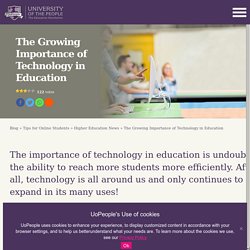
By accessing scholarly articles from your university’s database, for example, you can easily choose to continue your studies from another country or without leaving your home. Students don’t even need to enroll in a full degree program to learn from the best universities in the world. Typically free for students, most academic journals will offer full digital versions of books originally produced in print. Even if you are not currently studying or involved in the education community, various articles, videos, etc., can be downloaded right to your phone, making the learning process both easily accessible as well as mobile. Because of technology, education is becoming more flexible and accessible.
Integrating Technology with Bloom’s Taxonomy - Teach Online. Creating authentic learning experiences for students is an essential element in online course delivery. Through recent discussion instructors have inquired “How do we provide meaningful learning experiences for students using tools that are intrinsically motivating?” 2 Questions as such imply the need to provide instructors with “. . . innovative ways of integrating technology that encourage higher-order thinking skills.” 2 Research indicates that “Today’s students, regardless of demographics, have shown an interest in digital opportunities to learn, and the range of Web 2.0 tools that make collaboration, innovation, and individual exploration possible is incredible.” 2 Practitioners within the field of education have thought of unique ways to connect digital tools with the framework of Bloom’s Revised Taxonomy, which has led to the emergence of a Digital Bloom’s Taxonomy.
SAMR: A Powerful Model for Understanding Good Tech Integration. The biggest obstacle to teaching online probably isn’t the technology.
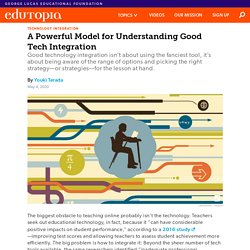
Teachers seek out educational technology, in fact, because it “can have considerable positive impacts on student performance,” according to a 2016 study—improving test scores and allowing teachers to assess student achievement more efficiently. The big problem is how to integrate it: Beyond the sheer number of tech tools available, the same researchers identified “inadequate professional development and training” as the primary obstacle to using technology productively in classrooms.
Understandably, the emergence of the coronavirus has dramatically accelerated the process of integrating edtech, as educators around the country race to get online as fast as they can. But as many of our teachers have noted, the current state of K-12 online learning is more like triage—a form of crisis management—and not at all like skillfully managed distance education. Introduction to the TPACK Model Video Common Sense Media.
Educational Technology. TPACK, shown below, is a useful model for educators as they begin to use digital tools and strategies to support teaching and learning.
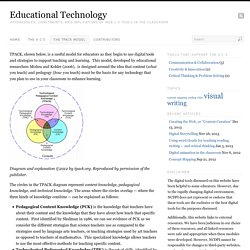
This model, developed by educational researchers Mishra and Kohler (2006), is designed around the idea that content (what you teach) and pedagogy (how you teach) must be the basis for any technology that you plan to use in your classroom to enhance learning. Diagram and explanation ©2012 by tpack.org. Reproduced by permission of the publisher. The circles in the TPACK diagram represent content knowledge, pedagogical knowledge, and technical knowledge. The SAMR Swimming Pool. SAMR. Academic Writer Tutorial: Basics of Seventh Edition APA Style - Overview. Academic Writer Tutorial: Basics of Seventh Edition APA Style.
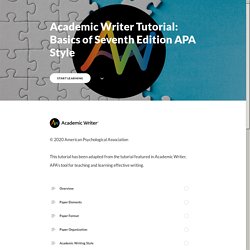
4 Important Videos to Help Students Use The Internet Smartly. Tech Support Guy - Free computer help. CleanMyMac X: The Best Mac Cleanup App for macOS. Get a Cleaner Mac in Minutes.